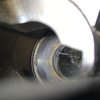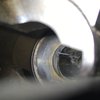I have a friendly competition coming up later this month and I didn't have time to dial in a particular handload with my current supplies, so I just ended up buying a few boxes of Hornady Match ammo.

I was sighting in at the range today, it was pretty uneventful at first. Two shots one hole at 50. Move it out to 100, still tight but starting to spread. Maybe it was me, but I call this rifle the laser for a reason.
The 9th shot was louder and recoiled more than the rest. It felt like someone sling shot sand into my face. No lasting pain, just more startled than anything else (had safety squints on). This is what came out of the chamber.

I've never had a case split on me before, but I certainly expected the first time it happened to be one of my own loads, not factory ammo. So now I'm kinda wondering what next. Is there any risk to damage to my rifle?
The split case was the last round I fired. I packed up and left. Looking down with a flashlight, I can see the same long mark down the length of the chamber. But aside from that, I'm not sure what I'd be looking for.
Some other questions:

I was sighting in at the range today, it was pretty uneventful at first. Two shots one hole at 50. Move it out to 100, still tight but starting to spread. Maybe it was me, but I call this rifle the laser for a reason.
The 9th shot was louder and recoiled more than the rest. It felt like someone sling shot sand into my face. No lasting pain, just more startled than anything else (had safety squints on). This is what came out of the chamber.

I've never had a case split on me before, but I certainly expected the first time it happened to be one of my own loads, not factory ammo. So now I'm kinda wondering what next. Is there any risk to damage to my rifle?
The split case was the last round I fired. I packed up and left. Looking down with a flashlight, I can see the same long mark down the length of the chamber. But aside from that, I'm not sure what I'd be looking for.
Some other questions:
- I don't feel comfortable firing the rest of this box, but what about the other two boxes. If the lots are not sequential should I consider them safe?
- Is hornady generally willing to reimburse people for their troubles, or should I be dealing with the gun store (Bass Pro) ?
























